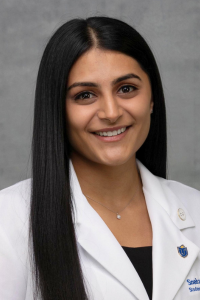From Blueberries to Beta-Oxidation: How AAPI Heritage Shaped My Journey in Medicine
Published June 03, 2025
Inside OME

By Sneha Misra, OMS I, Touro College of Osteopathic Medicine Montana
Growing up in an Asian American household, health wasn’t something we talked about—it was something we lived. Before I ever picked up a stethoscope, I learned the healing power of turmeric before it went viral, respected the gospel of hydration and understood that you didn’t just eat to be full—you ate to fuel.
My mom, an “innate osteopath” long before I knew what that meant, always believed in the body’s power to heal itself. She didn’t need a degree to understand biomechanics—she just knew that movement, rest and good food mattered. Whether it was tweaking our family’s meals to avoid inflammatory foods, or making sure our weekly schedule had time carved out for a brisk walk (which was never optional), she laid down the principles of preventive medicine in a way no textbook ever could.
Meanwhile, my dad expressed his love and support with surgical precision: one perfectly peeled orange, a neatly sliced mango or—if I was really lucky—a tiny bowl of blueberries, timed right when I was deep into studying. At the time, I didn’t realize those snacks were more than just sweet relief. But now, as a medical student, I know that blueberries are bursting with vitamin C, K, manganese and a host of polyphenols that make them neuroprotective and anti-inflammatory. Who knew dad was helping my neurons fire more efficiently with every bite?
As I’ve made my way through medical school, I’ve come to appreciate how these small, almost imperceptible moments of my upbringing—rooted deeply in culture—were shaping me into the kind of doctor I want to become. One who treats the whole person, not just the lab result. One who remembers that health is built long before someone walks into the clinic.
Take cardio, for example. Growing up, it wasn’t just exercise—it was a family ritual. We’d all head to Lifetime Fitness together, sometimes half-asleep but always showing up. It was less about hitting a PR and more about showing up for each other—walking on treadmills side by side, exchanging smiles between reps, sometimes even racing on the rowing machines, and other times just going to sit in the sauna like we’d earned it. Back then, I had no idea what “level 2 cardio” meant, I just knew it felt refreshing. Now I know that those steady sessions were improving mitochondrial efficiency and training our muscles to use fat as fuel. The science adds meaning, but the habit came first. My parents weren’t reading exercise physiology papers—they were writing their own kind of health manual, just by leading with consistency and care.
In many ways, this is the beauty of the AAPI experience in medicine. It’s not just about representation—it’s about integration. It’s about bringing in generations of wisdom, discipline and love—yes, even the tough love of “drink your hot water!”—and pairing it with modern science. It’s about recognizing that healing is as much cultural as it is clinical.
As I look forward to becoming a physician, I carry my heritage with humility and pride. I know that when I counsel a patient on lifestyle changes, I’m echoing the same values my mom embodied in our kitchen and my dad delivered in a fruit bowl. This journey has taught me that medicine isn’t just what we learn in school—it’s what we live, what we inherit and what we choose to pass on.
And somewhere along the way, I’ve realized the best treatments sometimes start not in the pharmacy—but in the produce aisle.
